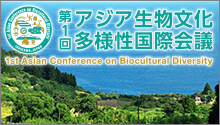An international symposium exploring the concept of green infrastructure in urban landscapes was held in Kanazawa, which in 2018 marked 50 years since its Ordinance on the Preservation of the Traditional Environment (Currently Ordinance on urban planning with beautiful landscape in Kanazawa) entered into force. Green infrastructure refers to land use planning that aims to achieve sustainable development by reassessing nature from a multifunctionality perspective. Because of this ordinance, the vegetated slopes, canals, riverfronts, temples, traditional gardens and other unique elements integrated with the city’s landscape and scenery have been conserved and restored. This symposium invited experts from various fields in and outside Japan to participate in a discourse on whether Kanazawa’s urban landscape could be redefined as green infrastructure.
In Part 1, titled “Understanding Green Infrastructure”, examples of green infrastructure around the world were introduced. Various viewpoints were presented — for example, that utilizing existing canals, parking lots, and other infrastructure is an important part of building livable cities, and that green infrastructure should be defined by each region.
In Part 2, research and initiatives related to green infrastructure, mainly in Kanazawa, were presented on the symposium’s theme. In a report from the perspectives of disaster risk reduction, the environment, and economy, the unique potential of green infrastructure in Kanazawa was discussed, with unusual benefits connected to crime deterrence and education being described. In a presentation on the need for sustainable conservation efforts and collaborative management, it was proposed that sustainable conservation could be realized in conjunction with Goals 11, 15, and 17 of the SDGs.
Part 3 was held as a roundtable in which attendees discussed the use of urban landscapes as green infrastructure. Lots of views were expressed, including comparisons between green and gray infrastructure, the advantages of substituting the words “nature protection/conservation” with green infrastructure, and that visualizing the multifunctional benefits of green infrastructure is critical to deepening our understanding of it.
As ideas were shared, we at OUIK felt that this symposium was a tangible first step in disseminating from Kanazawa a theoretical framework on urban planning and green infrastructure that will allow communities worldwide to advance sustainable development in a unified way.




